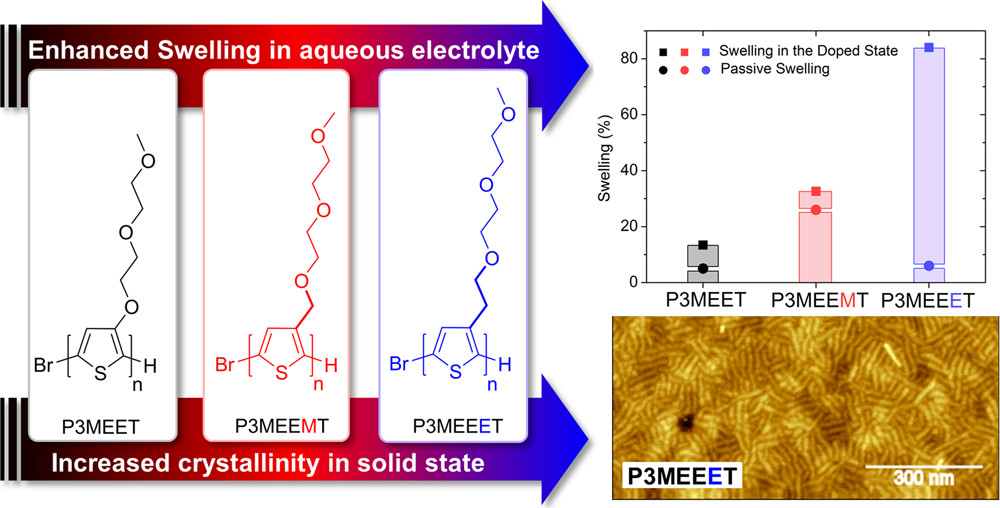
Functionalizing conjugated polymers with polar ethylene glycol side chains enables enhanced swelling and facilitates ion transport in addition to electronic transport in such systems. Here, we investigate three polythiophene homopolymers (P3MEET, P3MEEMT, and P3MEEET) having differently linked (without spacer and with methyl and ethyl spacer, respectively) diethylene glycol side chains. All the polymers were tested in organic electrochemical transistors (OECTs). They show drastic differences in the device performance. The highest μOECTC* product of 11.5 F/cm·V·s was obtained for ethyl-spaced P3MEEET. How the injection and transport of ions is influenced by the side-chain linkage was studied with electrochemical impedance spectroscopy, which shows a dramatic increase in volumetric capacitance from 80 ± 9 up to 242 ± 17 F/cm3 on going from P3MEET to P3MEEET. Thus, ethyl-spaced P3MEEET exhibits one of the highest reported volumetric capacitance values among p-type polymers. Moreover, P3MEEET exhibits in dry thin films an organic field-effect transistor (OFET) hole mobility of 0.005 cm2/V·s, highest among the three, which is one order of magnitude higher than that for P3MEEMT. The extracted hole mobility from OECT (oxidized swollen state) and the hole mobility in solid-state thin films (OFET) show contradictory trends for P3MEEMT and P3MEEET. In order to understand exactly the properties in the hydrated and dry states, the crystal structure of the polymers was investigated with wide-angle X-ray scattering (WAXS) and grazing incidence WAXS, and the water uptake under applied potential was monitored using electrochemical quartz crystal microbalance with dissipation monitoring (E-QCMD). These measurements reveal an amorphous state for P3MEET and a semicrystalline state for P3MEEMT and P3MEEEET. On the other hand, E-QCMD confirms that P3MEEET swells 10 times more than P3MEEMT in the oxidized state. Thus, the importance of the ethyl spacer toward crystallinity and mixed-conduction properties was clearly demonstrated, emphasizing the impact of side chain linkage of diethylene glycol. This detailed study offers a better understanding of how to design high-performance organic mixed conductors.


"KAUST shall be a beacon for peace, hope and reconciliation, and shall serve the people of the Kingdom and the world."
King Abdullah bin Abdulaziz Al Saud, 1924 – 2015
Thuwal 23955-6900, Kingdom of Saudi Arabia
© King Abdullah University of Science and Technology. All rights reserved